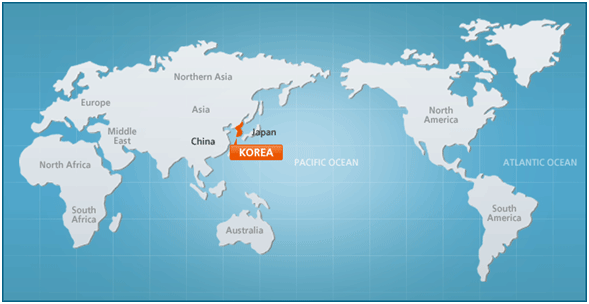
Korea is situated on the Korean Peninsula, which spans 1,100 kilometers north to south. The Korean Peninsula lies on the northeastern section of the Asian continent, where Korean waters are joined by the western-most parts of the Pacific. The peninsula shares its northern border with China and Russia. To its east is the East Sea, beyond which neighboring Japan lies. In addition to the mainland peninsula, Korea includes some 3,000 islands.
Located in a temperate zone and blessed with four distinct seasons, Korea, once known as the "Land of the Morning Calm", is a country that boasts a rapidly growing economy that combines the old and the new. Being a fascinating country with 5,000 years of history, Korea blends harmoniously its rich heritage with new advances and modernizations!

Home General Information Host Country, Korea
The Korean peninsula extends southward from the eastern end of the Asian continent. It is roughly 1,000 km (621 miles) long and 216 km (134 miles) wide at its narrowest point. Mountains cover 70% of the land mass, making it one of the most mountainous regions in the world. The peninsula is divided just slightly north of the 38th parallel. South Korea has a population of 50 million and consists of nine provinces, capital Seoul, six metropolitan cities, and an additional 77 cities and 88 counties. For more information,
Korea lies in a temperate zone and has four distinct seasons.

SPRING
In late March or early April, the trees burst into leafy splendor to mark the beginning of spring. Mostly sunny days can be expected from March to May.

SUMMER
During the relatively hot and rainy summer season, the vegetation is lush. By June the average temperature is over 20°C(68°F). Monsoon rains usually begin around the end of June and last until mid-to-late July. August is hot and humid.

AUTUMN
The coming of autumn in late September brings continental winds and clear, dry weather, making these months perhaps the most pleasant time of year. October's vivid gold and vibrant reds create a colorful panorama.

WINTER
December to February are cold and dry with occasional snow. During the winter months, three or four days of cold weather are often followed by a few warmer days.

National Flag
The Korean flag is called taegeukgi. The design symbolizes the principles of the yin and yang in Asian philosophy. The circle in the center of the flag is divided into two equal parts. The red half represents the proactive cosmic forces of the yang. Conversely, the blue half represents the responsive cosmic forces of the yin. The two forces together embody the concepts of continual movement, balance, and harmony that characterize the sphere of infinity. The circle is surrounded by four trigrams, one in each corner. Each trigram symbolizes one of the four universal elements: Heaven, Earth, Fire and water.

National Flower
The national flower of Korea is the mugunghwa (Rose of Sharon). Every year from July to October, a profusion of mugunghwa blossoms graces the entire country. The flower's symbolic significance stems from the Korean word mugung (immortality).

Language
The Korean language like Hungarian, Turkish, Mongolian and Finnish, is classified into the Ural-Altaic language group. Hangeul (the Korean alphabet) is composed of 10 simple vowels and 14 consonants. A group of scholars under the of King Sejong the Great developed this systematic rendition of spoken sound in 1443. It is widely acclaimed by linguists as an ingenious invention. In 2009, the town of Bau-Bau, in Sulawesi, Indonesia adopted Hangeul as their official written language.

Travel Hotline
Need travel information? Just Call 1330 How to use it!